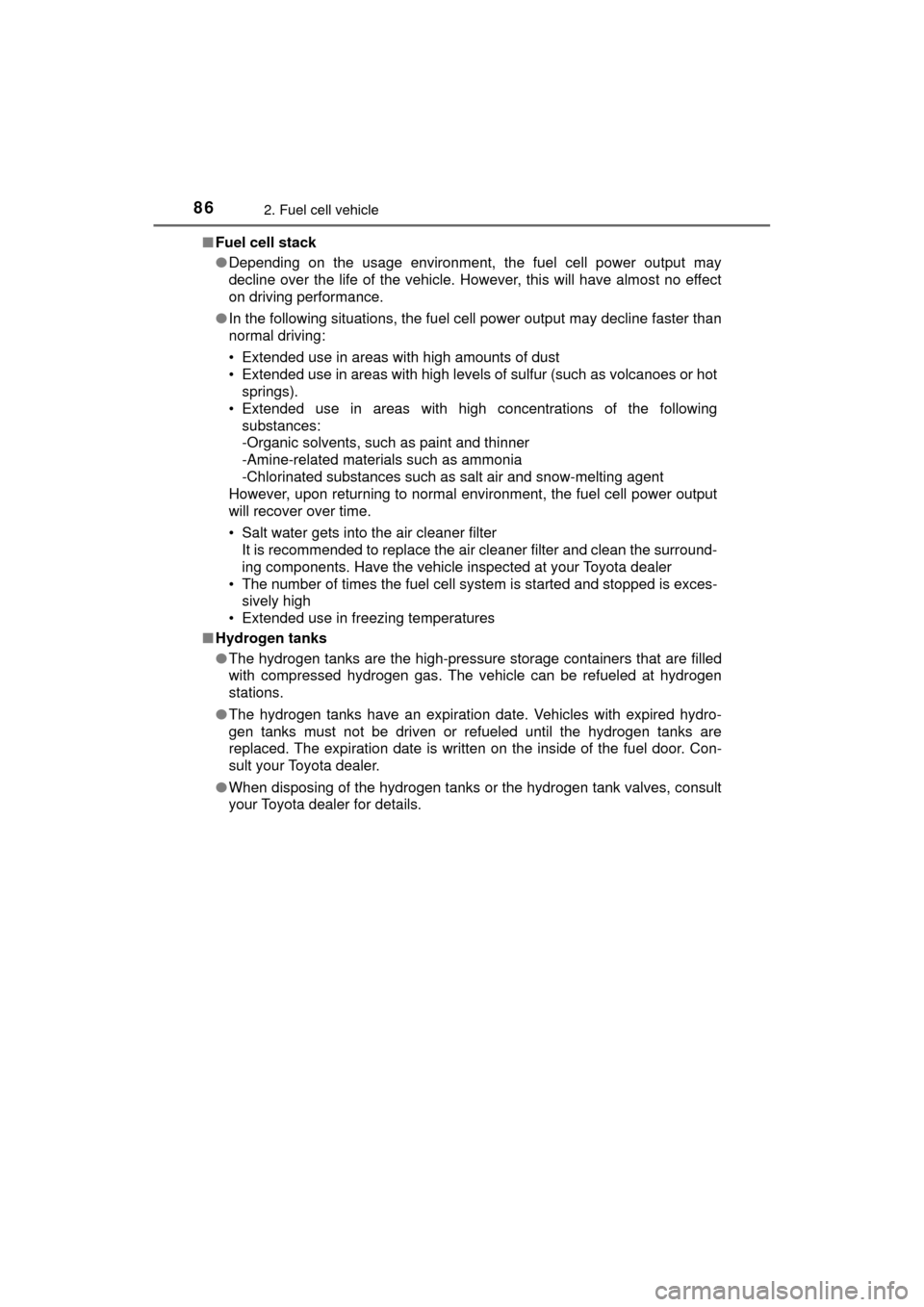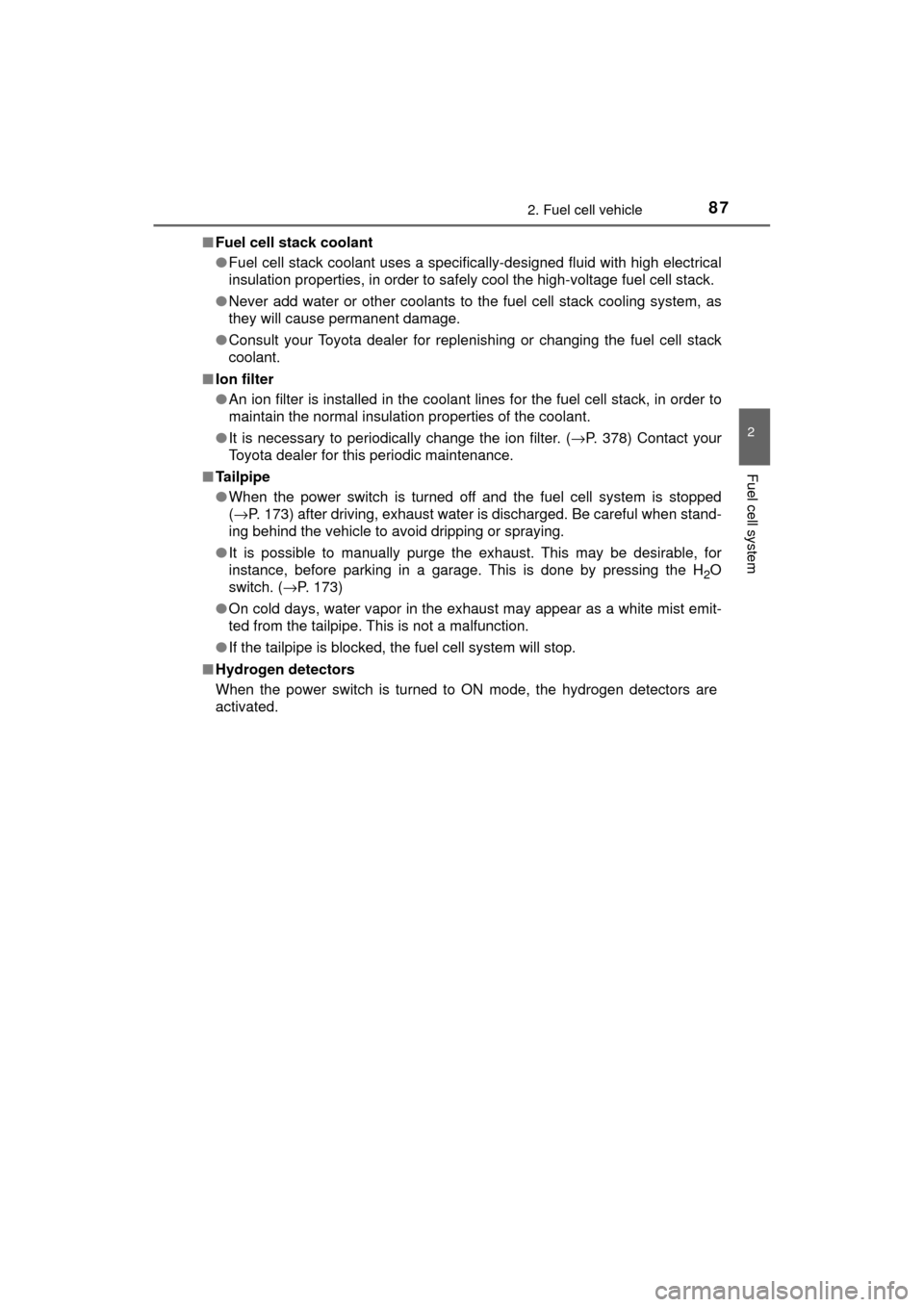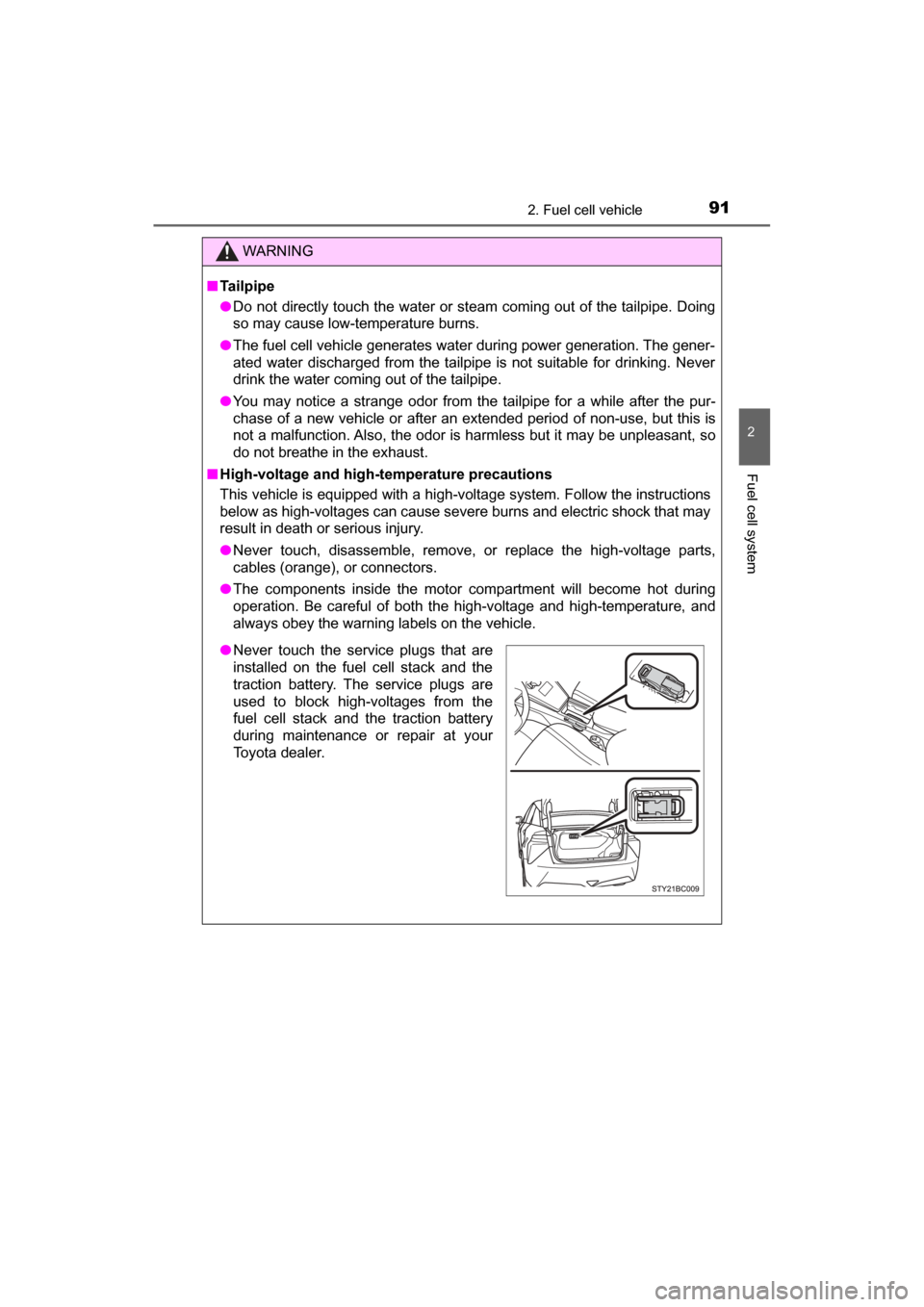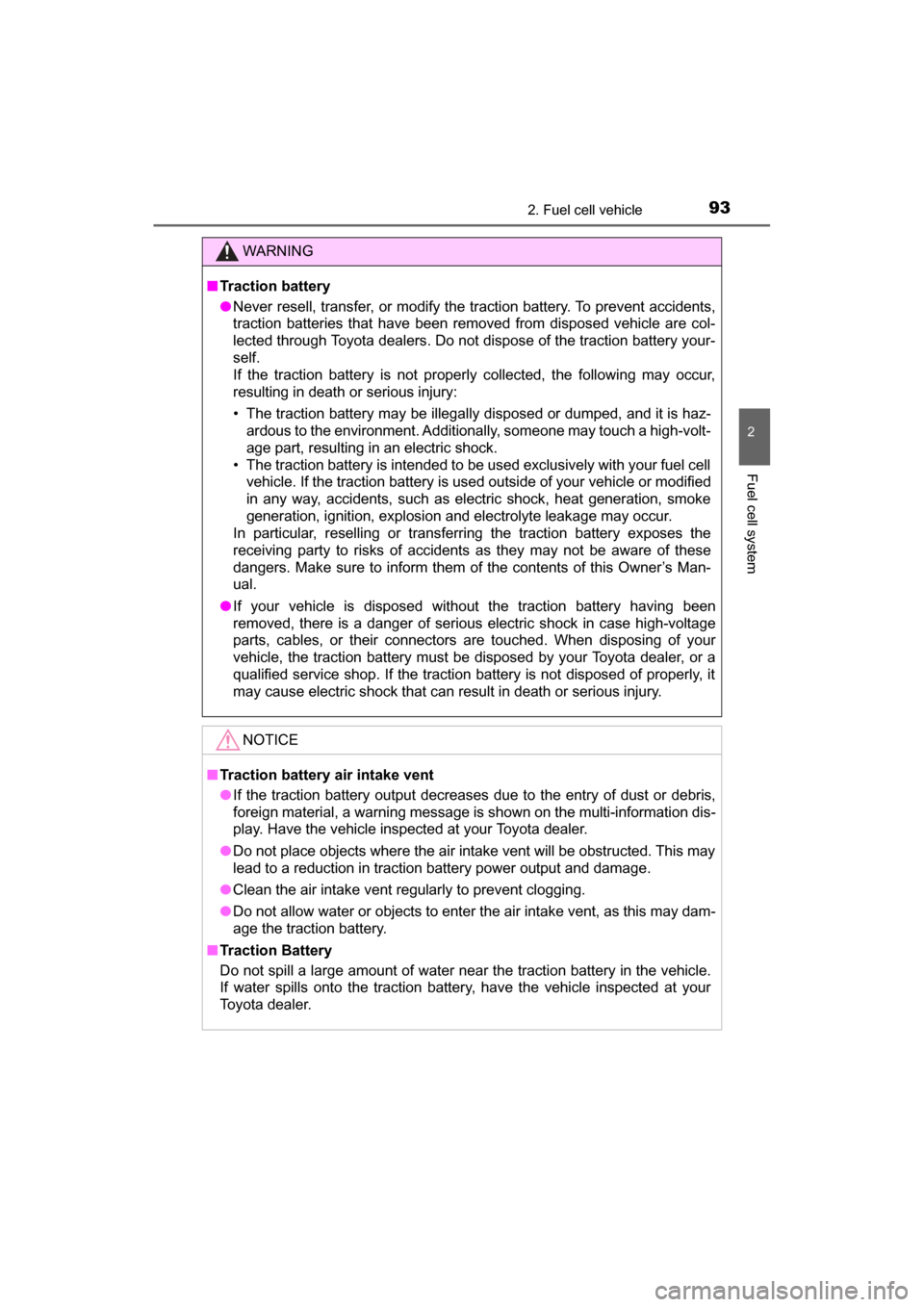2017 TOYOTA MIRAI fuel system
[x] Cancel search: fuel systemPage 84 of 464

842. Fuel cell vehicle
MIRAI_OM_USA_OM62023U
When a certain level of impact from an accident is detected, the fuel
cell system is shut down and the system shuts out the high voltage.
Also, the fuel supply is stopped from the hydrogen tank valves. If the
emergency shut off system activates, your vehicle will not restart. To
restart the fuel cell system, contact your Toyota dealer.
A message is automatically displa yed when a malfunction occurs in
the fuel cell system or an im proper operation is attempted.
If a warning message is shown on
the multi-information display, read
the message and follow the
instructions. ( →P. 376)
Fuel cell vehicles do not have engi ne sounds like gasoline vehicles.
Therefore, it makes an artificial no ise at low speeds to notify pedestri-
ans and nearby vehicles that it is approaching. The sound varies with
speed and will stop when the v ehicle exceeds approximately 15 mph
(25 km/h).
Emergency shut off system
Fuel cell warning message
Vehicle proximity notification system
Page 85 of 464

852. Fuel cell vehicle
2
Fuel cell system
MIRAI_OM_USA_OM62023U
There is an air intake vent beside
the rear left seat for the purpose
of cooling the traction battery. If
the air intake vent is blocked, it
could lead to a reduction in trac-
tion battery output.
■ If a warning light comes on, a warn ing message is displayed, or the 12-
volt battery connection is disconnected
The fuel cell system may not be able to restart.
If the “READY” indicator does not come on, even when the start pro\
cedure is
repeated, contact your Toyota dealer.
■ If “Hydrogen Leakage Detected Visit Your Dealer” is displayed on the
multi-information display
A small amount of hydrogen gas may be leaking. Have the vehicle inspected
immediately at the nearest Toyota dealer.
■ If “FC System Shutdown due to Hydrogen Leakage Stop Your Vehicle in
a Safe Place and Contact Your Dealer ” is displayed on the multi-informa-
tion display
● Hydrogen gas may be leaking.
When hydrogen gas is leaking or some other malfunction is detected:
→P. 9 0
● The air conditioning system will shut off automatically.
■ Running out of fuel
When the vehicle has run out of fuel and the fuel cell system cannot be
started, refuel the vehicle until the low fuel level warning light ( →P. 371) turns
off before trying to restart. It may not be able to restart if the refueled amount
is too low (less than about 2.7 lb. [1.2 kg]).
Traction battery air intake vent
Page 86 of 464

862. Fuel cell vehicle
MIRAI_OM_USA_OM62023U■
Fuel cell stack
●Depending on the usage environment, the fuel cell power output may
decline over the life of the vehicle. However, this will have almost no effect
on driving performance.
● In the following situations, the fuel cell power output may decline faster than
normal driving:
• Extended use in areas with high amounts of dust
• Extended use in areas with high levels of sulfur (such as volcanoes or hot
springs).
• Extended use in areas with high concentrations of the following substances:
-Organic solvents, such as paint and thinner
-Amine-related materials such as ammonia
-Chlorinated substances such as salt air and snow-melting agent
However, upon returning to normal environment, the fuel cell power output
will recover over time.
• Salt water gets into the air cleaner filter It is recommended to replace the air cleaner filter and clean the surround-
ing components. Have the vehicle inspected at your Toyota dealer
• The number of times the fuel cell system is started and stopped is exces- sively high
• Extended use in freezing temperatures
■ Hydrogen tanks
●The hydrogen tanks are the high-pressure storage containers that are filled
with compressed hydrogen gas. The vehicle can be refueled at hydrogen
stations.
● The hydrogen tanks have an expiration date. Vehicles with expired hydro-
gen tanks must not be driven or refueled until the hydrogen tanks are
replaced. The expiration date is written on the inside of the fuel door. Con-
sult your Toyota dealer.
● When disposing of the hydrogen tanks or the hydrogen tank valves, consult
your Toyota dealer for details.
Page 87 of 464

872. Fuel cell vehicle
2
Fuel cell system
MIRAI_OM_USA_OM62023U■
Fuel cell stack coolant
●Fuel cell stack coolant uses a specifically-designed fluid with high electrical
insulation properties, in order to safely cool the high-voltage fuel cell stack.
● Never add water or other coolants to the fuel cell stack cooling system, as
they will cause permanent damage.
● Consult your Toyota dealer for repleni shing or changing the fuel cell stack
coolant.
■ Ion filter
●An ion filter is installed in the coolant lines for the fuel cell stack, in order to
maintain the normal insulation properties of the coolant.
● It is necessary to periodically change the ion filter. ( →P. 378) Contact your
Toyota dealer for this periodic maintenance.
■ Tailpipe
●When the power switch is turned off and the fuel cell system is stopped
(→P. 173) after driving, exhaust water is discharged. Be careful when stand-
ing behind the vehicle to avoid dripping or spraying.
● It is possible to manually purge the exhaust. This may be desirable, for
instance, before parking in a garage. This is done by pressing the H
2O
switch. ( →P. 173)
● On cold days, water vapor in the exhaust may appear as a white mist emit-
ted from the tailpipe. This is not a malfunction.
● If the tailpipe is blocked, the fuel cell system will stop.
■ Hydrogen detectors
When the power switch is turned to ON mode, the hydrogen detectors are
activated.
Page 88 of 464

882. Fuel cell vehicle
MIRAI_OM_USA_OM62023U■
Power output restriction
When the power output is restricted, the vehicle may fail to accelerate or even
decelerate, even though the accelerator pedal is depressed. If a safe driving
speed cannot be maintained, stop the vehicle in a safe place away from the
traffic. This may be caused by the following conditions:
●The coolant temperature may be too high. This can be caused by driving
conditions such as repeated sudden acceleration and deceleration, continu-
ous driving on an incline, continuous driving at high altitudes with a high
load, etc. In such situations, the power output restriction indicator (amber) is
displayed on the main display, “High FC Temperature Reduced Power” is
displayed on the multi-information display, and the power output is
restricted. Once the coolant returns to normal temperature, the power out-
put will return to normal. ( →P. 377)
● The remaining fuel may be low. After the low fuel warning indicator comes
on, the output power will be gradually restricted in order to extend the possi-
ble driving distance. Once getting to this point, the remaining driving dis-
tance possible is short. Immediately refill the vehicle with hydrogen.
● On cold days, the low fuel warning indicator comes on faster than usual and
the output power is restricted.
■ Vehicle proximity notification system
In the following cases, the vehicle proximity notification system may be diffi-
cult to hear for people around.
●In very noisy areas
● In wind or rain
Also, because the vehicle proximity notification system is located in the front
of the vehicle, it may be more difficult to hear from the rear of the vehicle
compared to the front.
■ Electromagnetic waves (EMF)
●High-voltage parts and cables in fuel cell vehicles have an electromagne\
tic
shielding configuration, and therefore emit approximately the same amount
of electromagnetic waves as conventional gasoline-powered vehicles or
home electronic appliances.
● Your vehicle may cause sound interference in some third party-produced
radio parts.
■ Traction battery
The traction battery has a limited service life. The lifespan of the traction bat-
tery can change according to driving style and driving conditions.
Page 89 of 464

892. Fuel cell vehicle
2
Fuel cell system
MIRAI_OM_USA_OM62023U■
Hydrogen Gas Characteristics
●Hydrogen gas ignites more easily than gasoline. However, it is lighter than
air and disperses quickly. So even if hydrogen were to leak from the system,
it would quickly dilute until it is no longer flammable.
● As with gasoline and natural gas, hydrogen gas is not dangerous if it is han-
dled properly. Thoroughly read and understand the characteristics shown in
the table below.
Hydrogen gas
LPG
(Liquid Petroleum Gas)
Gasoline
Normal stateGaseous
(Lighter than air)Gaseous
(Heavier than air)
Volatile liquid
(evaporates
easily)
(Heavier than air)
Ease of
ignitionEasier than
gasolineAt the same level
as gasoline—
Ease of
accumulation
• Disperses
upward and is
diluted to safe
concentrations
in open air
• Does not adhere to
clothing
• Spreads on the
ground or floor
• Does not adhere to
clothing• Spreads on theground or floor
• Adheres to clothing
Detectability
•Due to itscolorless and
odorless state,
difficult to detect
by sight or smell
• Vehicle
hydrogen
detectors will
display a
warning on the
multi-
information
display
• Detectable by odor and gas
leaking noise• Detectable bycolor and odor
Page 91 of 464

912. Fuel cell vehicle
2
Fuel cell system
MIRAI_OM_USA_OM62023U
WARNING
■Tailpipe
● Do not directly touch the water or steam coming out of the tailpipe. Doing
so may cause low-temperature burns.
● The fuel cell vehicle generates water during power generation. The gener-
ated water discharged from the tailpipe is not suitable for drinking. Never
drink the water coming out of the tailpipe.
● You may notice a strange odor from the tailpipe for a while after the pur-
chase of a new vehicle or after an extended period of non-use, but this is
not a malfunction. Also, the odor is harmless but it may be unpleasant, so
do not breathe in the exhaust.
■ High-voltage and high-temperature precautions
This vehicle is equipped with a high-voltage system. Follow the instructions
below as high-voltages can cause severe burns and electric shock that may
result in death or serious injury.
● Never touch, disassemble, remove, or replace the high-voltage parts,
cables (orange), or connectors.
● The components inside the motor compartment will become hot during
operation. Be careful of both the high-voltage and high-temperature, and
always obey the warning labels on the vehicle.
●Never touch the service plugs that are
installed on the fuel cell stack and the
traction battery. The service plugs are
used to block high-voltages from the
fuel cell stack and the traction battery
during maintenance or repair at your
Toyota dealer.
Page 93 of 464

932. Fuel cell vehicle
2
Fuel cell system
MIRAI_OM_USA_OM62023U
WARNING
■Traction battery
● Never resell, transfer, or modify the traction battery. To prevent accidents,
traction batteries that have been removed from disposed vehicle are col-
lected through Toyota dealers. Do not dispose of the traction battery your-
self.
If the traction battery is not properly collected, the following may occur,
resulting in death or serious injury:
• The traction battery may be illegally disposed or dumped, and it is haz-
ardous to the environment. Additionally, someone may touch a high-volt-
age part, resulting in an electric shock.
• The traction battery is intended to be used exclusively with your fuel cell vehicle. If the traction battery is used outside of your vehicle or modified
in any way, accidents, such as electric shock, heat generation, smoke
generation, ignition, explosion and electrolyte leakage may occur.
In particular, reselling or transferri ng the traction battery exposes the
receiving party to risks of accidents as they may not be aware of these
dangers. Make sure to inform them of the contents of this Owner’s Man-
ual.
● If your vehicle is disposed without the traction battery having been
removed, there is a danger of serious electric shock in case high-voltage
parts, cables, or their connectors are touched. When disposing of your
vehicle, the traction battery must be disposed by your Toyota dealer, or a
qualified service shop. If the traction battery is not disposed of properly, it
may cause electric shock that can result in death or serious injury.
NOTICE
■ Traction battery air intake vent
● If the traction battery output decreases due to the entry of dust or debris,
foreign material, a warning message is shown on the multi-information dis-
play. Have the vehicle inspected at your Toyota dealer.
● Do not place objects where the air intake vent will be obstructed. This may
lead to a reduction in traction battery power output and damage.
● Clean the air intake vent regularly to prevent clogging.
● Do not allow water or objects to enter the air intake vent, as this may dam-
age the traction battery.
■ Traction Battery
Do not spill a large amount of water near the traction battery in the vehicle.
If water spills onto the traction battery, have the vehicle inspected at your
Toyota dealer.